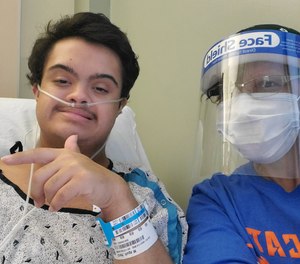
Personal experience showed me the impact of grants in getting crews the tools they need to help patients like my son
2020 marked my 20th year of working directly with public safety agencies. Prior to that, my grant writing experience was centered on nonprofits and youth recreation programs.
I come from a family with a long history of service to community and country. Having an opportunity to devote my career to public safety has been a dream come true. There is a job and a passion. For me, helping the first responder community is my passion.
I have been a part of the FireGrantsHelp and EMSGrantsHelp teams for 10 years, but never had a need for any of the service from the departments, nor products that we represent, until the COVID-19 pandemic made my life feel like something out of a scary movie.
My 19-year-old son was born with Down syndrome and is taught in an autistic support classroom.
He was exposed to COVID-19 on the first day of school and spiked a fever seven days later.
Trying to get a COVID test for a person who is unable to articulate their symptoms was an ordeal. Twelve days after the initial exposure, I dialed 9-1-1.
We normally like seeing a fire truck, ambulance and uniformed personnel. Not so much when it’s needed at your own home. But the first responders were phenomenal with my son.
Worried that a ride in the ambulance would cause additional trauma, we opted to use personal transport. Two members of the ambulance company made sure that my son was stable and helped him get dressed, before walking him to my car.
At the hospital, it was confirmed that my son had COVID-19. After my son received a few bags of fluids, we were on our way home to continue our quarantine.
Act I comes to an end with hopes for a speedy recovery.
Less than 48 hours later, we were in crisis mode. I know my son. This was bad. The fear of what had transpired days before – the unfamiliar environment, the needles, etc. – caused him to refuse to get into my car.
I dialed 9-1-1 and relayed to the dispatcher that my son was COVID-19-positive with a temperature over 102 degrees F, and combative. Remember, he is a special needs individual. He did not understand what was happening.
Once again, a fire truck pulled up first. They knew what they were walking in to. THEY DID NOT PAUSE.
Moments later, a different ambulance company arrived. THEY DID NOT PAUSE.
I won’t go into all of the details, but just know that my 5'0ʺ, 130-lb. teenager with a highly infectious disease was ready to do battle with a 6'3ʺ, 250+-lb. man.
Due to my son’s preexisting medical issues, every moment was crucial to his survivability.
Send in the props: As I felt myself start to break down, my brain told me to disconnect from emotions. I began to notice the equipment being used – equipment I recognized from my work as a grant writer for fire and EMS agencies.
For example, when I gave consent for a sedative to be used, two things struck me: the radios personnel used to communicate and the ruggedize tablet to confirm dosage and document the continuum of care. I had written grants for just this type of equipment.
Even sedated, it took three of us to transfer my naked son onto a flexible medical stretcher … a stretcher I recognized.
Still refocusing my energy, I transferred my thoughts to the power stretcher. At the ambulance, I marveled at the ease in which the stretcher was loaded into the vehicle without risking injury to the personnel or my son, who was struggling to be released. My eyes took in the interior of the ambulance as vitals were once again taken. I remember staring at my son’s finger as they checked his oxygen level, and I remember having to turn away when my eyes locked in on the AED.
I was able to ride to the hospital in the ambulance with my son because of his disability. I wondered about the people who stepped up to care for us. Had they been informed of the COVID-19 diagnosis before walking into my home? Were these things being tracked to help keep them safe?
As we walked into the emergency room, I reached into my purse and handed them my business card for EMSGrantsHelp. If they need me, I will be there to help secure funds for our community and to keep them safe so that they can go home to their families.
I got to spend Christmas with my son.
The recent death of a local paramedic due to COVID-19 brought back every moment of my family’s experience. I know the brand name of the gloves, IV pole, paper towel holder, digital thermometer, etc., that was in the small hospital room throughout our stay. There were many of the companies that our grants program has represented over the years.
I can’t explain how proud I am to be a part of a team of experts who will aid agencies from across the country as the FY2020 Assistance to Firefighter Grants program period now open. We’ve got work to do. I’m looking forward to better days.
To our first responder community, thank you!
White Rose Ambulance
York Area United Fire and Rescue
Grantley Fire and EMS
Wellspan: York Hospital
Copyright © 2024 FireGrantsHelp.com. All rights reserved.
